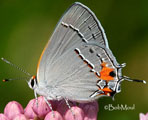Native Plants
Search for native plants by scientific name, common name or family. If you are not sure what you are looking for, try the Combination Search or our Recommended Species lists.
Quercus palustris
Quercus palustris Münchh.
Pin Oak, Swamp Spanish Oak
Fagaceae (Beech Family)
Synonym(s):
USDA Symbol: qupa2
USDA Native Status: L48 (N), CAN (N)
Straight-trunked tree with spreading to horizontal branches, very slender pinlike twigs, and a broadly conical crown. Pin oak is a stongly pyramidal tree with a distinct central leader, growing 60-70 ft. or taller. Instead of the gnarled, massive qualities of most oaks, pin oak has a more graceful, slender appearance. Old trees become high-crowned after shedding lower limbs. Dark-green foliage becomes dark-red in fall. Leaves persist into winter.
Named for the many short side twigs or pinlike spurs. A popular, graceful lawn tree with regular compact form and fine-textured foliage, Pin Oak is hardy and easily transplanted because the shallow fibrous root system lacks tap roots.
Plant Characteristics
Duration: PerennialHabit: Tree
Leaf Retention: Deciduous
Leaf Arrangement: Alternate
Leaf Complexity: Simple
Leaf Venation: Pinnate
Breeding System: Flowers Unisexual , Monoecious
Inflorescence: Catkin
Fruit Type: Nut
Size Notes: Up to about 75 feet tall.
Leaf: Green
Autumn Foliage: yes
Fruit: Brown
Bloom Information
Bloom Color: Yellow , Green , BrownBloom Time: Mar , Apr , May
Distribution
USA: AR , CT , DC , DE , GA , IA , IL , IN , KS , KY , MA , MD , ME , MI , MO , MS , NC , NE , NJ , NY , OH , OK , PA , RI , SC , TN , VA , WI , WVCanada: ON
Native Distribution: GA to OK, n. to MA, s. Ont., s. MI, IL, IA & e. KS
Native Habitat: Wet woods; bottomlands
Growing Conditions
Water Use: HighLight Requirement: Sun , Part Shade , Shade
Soil Moisture: Moist , Wet
Soil pH: Acidic (pH<6.8)
CaCO3 Tolerance: Low
Soil Description: Heavy, poorly drained soils.
Conditions Comments: One of the faster growing oaks. Tolerates wet feet. Intolerant of alkaline soils. Susceptible to iron chlorosis which causes yellow coloration in the leaves through the summer months and can eventually kill the tree. Somewhat tolerant of city conditions. Pin oak is shallow-rooted and easily transplanted, and it will tolerate urban conditions in areas well outside its natural range (Kershaw).
Benefit
Use Wildlife: Attracts songbirds, water birds, ground birds and mammals.Use Other: Black ink can be made from galls formed by insects by steeping the galls in a small amount of water with some iron filings. (Hosie)
Attracts: Birds , Butterflies , Hummingbirds
Larval Host: Gray Hairstreak
Butterflies and Moths of North America (BAMONA)
|
Gray Hairstreak (Strymon melinus)  Larval Host |
Propagation
Description: Oaks are most often propagated from seed. Plant outdoors or in deep containers to accomodate long initial taproot. Many oaks require cold temperatures to initiate shoot development. Protect outdoor beds with wire mesh to deter rodent predation.Seed Collection: Best quality acorns are picked or shaken from the tree. Collect when color has changed to brown. Best if sown immediately as acorns lose viability quickly in storage. Short-term storage in moist, shaded saw dust or sand. Acorns to be sown immediately can be soaked in hot water for 15 min. to prevent weevil infestation. Stored seed should be fumigated with methyl bromide.
Seed Treatment: Stratify at 32-41 degrees for 30-45 days.
Commercially Avail: yes
National Wetland Indicator Status
| Region: | AGCP | AK | AW | CB | EMP | GP | HI | MW | NCNE | WMVE |
| Status: | FACW | FACW | FAC | FACW | FACW |
From the National Organizations Directory
According to the species list provided by Affiliate Organizations, this plant is on display at the following locations:Mt. Cuba Center - Hockessin, DE
Bibliography
Bibref 1186 - Field Guide to Moths of Eastern North America (2005) Covell, C.V., Jr.Bibref 1185 - Field Guide to Western Butterflies (Peterson Field Guides) (1999) Opler, P.A. and A.B. Wright
Bibref 1620 - Gardening with Native Plants of the South (Reprint Edition) (2009) Wasowski, S. with A. Wasowski
Bibref 1258 - Trees of Ontario (2007) Kershaw, Linda
Search More Titles in Bibliography
Additional resources
USDA: Find Quercus palustris in USDA PlantsFNA: Find Quercus palustris in the Flora of North America (if available)
Google: Search Google for Quercus palustris
Metadata
Record Modified: 2015-09-30Research By: TWC Staff